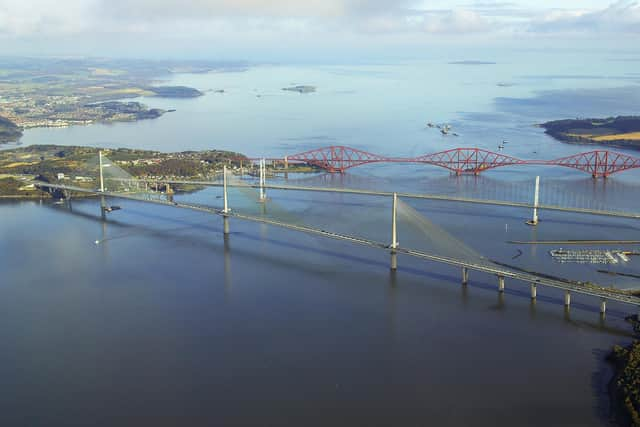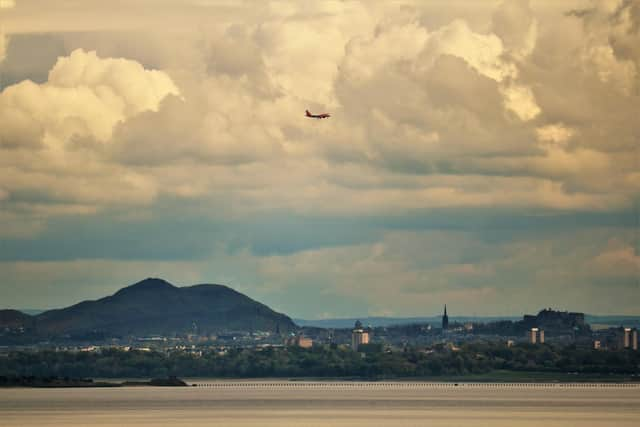Shorter east coast Edinburgh-London air route proposed for biggest airspace shake-up for 70 years
The changes could include a new shorter route between Edinburgh and the London airports on the east coast rather than the current path over Manchester by directing aircraft along the Forth.
They are designed to cut emissions and delays while also increasing capacity by enabling aircraft to fly more direct routes, which could involve changing their take-off and landing approaches.
Advertisement
Hide AdAdvertisement
Hide AdProposals for Edinburgh are expected to be published late next year, with those for Glasgow and Aberdeen following in the first half of 2024, for implementation from 2025. Changes at the other airports, in the north and west of England, Wales and London and the south of England, would follow in 2026-27.


The moves come four years after the Civil Aviation Authority rejected controversial plans by Edinburgh Airport to alter its flight paths, which followed noise concerns in areas such as Cramond and Livingston.
Edinburgh, Glasgow and Aberdeen are now to be the first of 22 airports across Britain to modernise their flight paths up to 7,000ft in a process being co-ordinated by the UK Government’s Airspace Change Organising Group (Acog), which was formed in 2019.
Mark Swan, who heads the group, told The Scotsman: “Glasgow and Edinburgh are in the vanguard of delivery of this programme – they are the tip of the spear."
He predicted the changes could cut emissions by up to 20 per cent in some areas by reducing the overall distance aircraft flew through faster, quicker climbs to cruising altitude.


Mr Swan said the shake-up had been triggered by the “unacceptable” levels of delays to a large proportion of flights in 2018. He said: “If nothing is done by 2030, one third of flights will be delayed by 30 minutes.”
He said aircraft noise levels would be reduced overall, but there may be winners and losers, adding: “Some people might get more noise than they had before, or they might not.”
Edinburgh Airport Noise Advisory Board, which comprises representatives of community councils from the Lothians, Fife and Falkirk, said a new east coast route via the Forth would be a “great step forward”.
Advertisement
Hide AdAdvertisement
Hide AdChair Lindsay Cole said: “The newly proposed route departing Edinburgh Airport towards the east, by following the Firth of Forth, overflies far fewer people. Several years ago, this would have been difficult to achieve due to conflict with RAF traffic from Leuchars in Fife.
"Since the closure of that RAF station, this route offers many advantages. Edinburgh lies to the west of London and so it also offers air traffic a much shorter route to the south.
"This makes it far more economical – a potential win for the airport, the airlines and the communities.
"The board has been central in promoting this alternative through our aviation sub-group, who work hand in hand with the airport's airspace change programme team and feel it is a great step forward.”
But campaigners Edinburgh Airport Watch, who are “seeking a fair deal” from the airport for the communities its flights pass over, said it was sceptical of the plans.
Founder member Helena Paul said: "We are disappointed to learn that Edinburgh Airport continues to pursue changes to flight paths around the airport.
"Local communities have learned from bitter experience how devastating and disruptive the impact of new and unwanted aircraft noise and other pollution can be for residents in their homes, schools and businesses.
"We would urge the public to ensure they scrutinise carefully any proposals the airport may choose to make and to comment accordingly.
Advertisement
Hide AdAdvertisement
Hide Ad“We would continue to press Edinburgh Airport to finally make progress on meaningful reductions in noise for the communities it flies over now, particularly during the night, and when designing new flight paths, not to sacrifice smaller and generally quieter rural communities simply because there might be fewer people living there."
Scottish Greens transport and environment spokesperson Mark Ruskell said: "We will welcome any changes that actually reduce emissions, but increased capacity is often a smokescreen for more flights and more pollution.
"The airspace change programme has so far been a botched consultation, with considerable opposition from communities who will face noise and disruption from anti-social night time flights and increased flight frequency.”
Edinburgh West Liberal Democrat MP Christine Jardine criticised the length of the process for causing uncertainty, more than six years after Edinburgh’s original proposals. She said: “It could become a decade of discussion. The level of frustration for communities is really high.
"There are still other issues to be resolved, including night flights.”
A spokesman for Edinburgh Airport said: “We’re at an early stage in the process to modernise the skies above the airport, where we are currently working through a range of options to take through to a public consultation.
"This is something that the UK Government has mandated all UK airports to do due to technological advances.
“By working closely with [air traffic controllers] National Air Traffic Services and Glasgow Airport, we’ve been able to identify changes to airspace infrastructure that will meet our criteria of modernisation whilst reducing the noise and carbon impact of flight paths across central Scotland.
Advertisement
Hide AdAdvertisement
Hide Ad“For Edinburgh specifically, one of the options we are looking at is the possibility of opening up the mouth of the River Forth. We hope to be consulting on our options in late 2023 and implementing any agreed and approved changes in 2025.”
A spokesperson for AGS Airports, which owns Aberdeen, Glasgow and Southampton airports, said: “A series of detailed and thorough stakeholder engagement sessions have been completed at our airports in Aberdeen and Glasgow that will help create a more efficient and sustainable airspace.
"As part of the next stage of the airspace change programme, we will assess the designs developed during the engagement sessions in order to produce fully-defined options ahead of our full public consultation in 2024.”
Comments
Want to join the conversation? Please or to comment on this article.